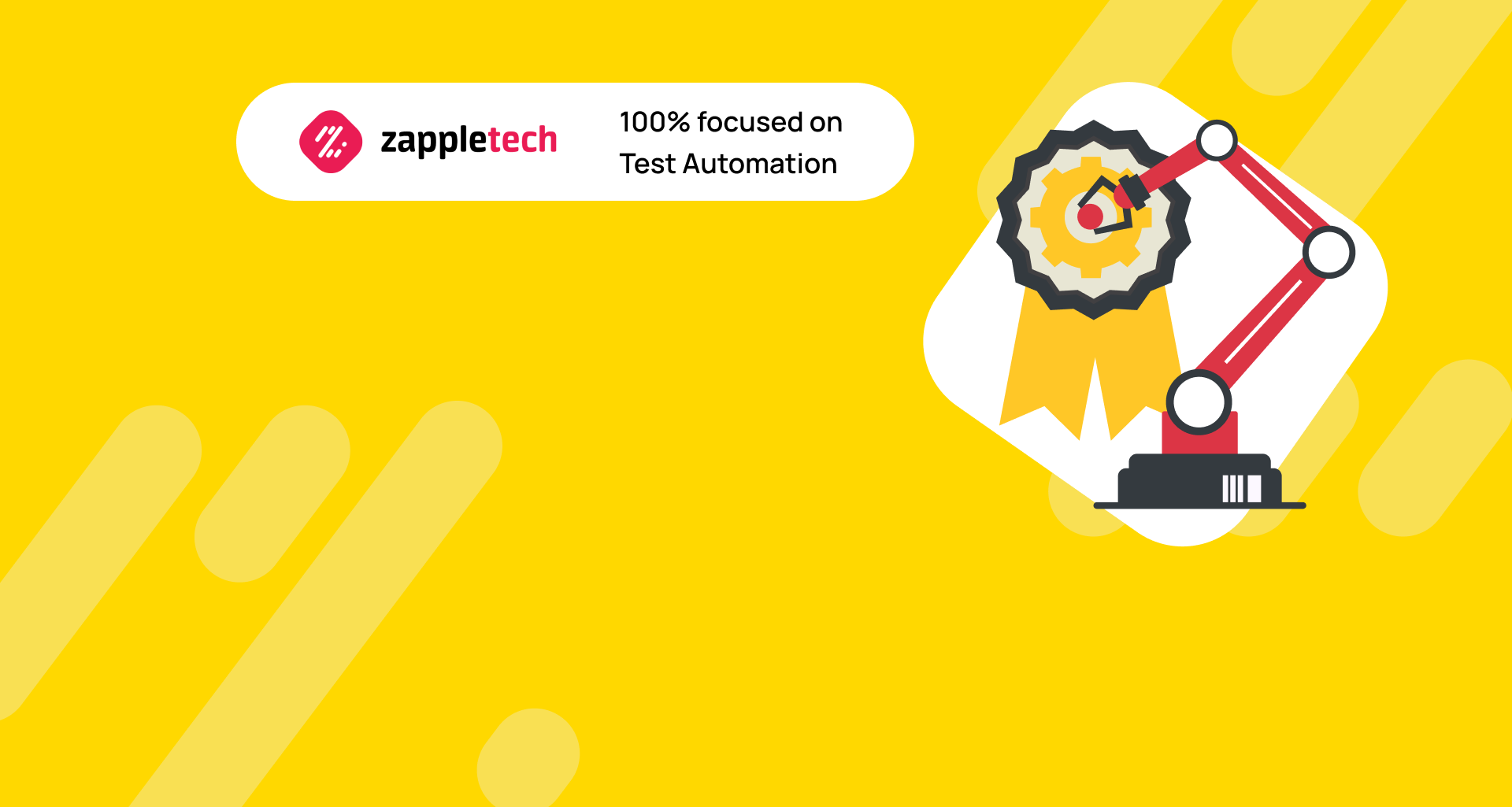Modern IT companies strive to optimize all processes and make them simpler. They focus on the speed of bringing the product to market and keeping appropriate quality. On this wave, a new approach to testing products is gaining popularity, called TestOps. What is this methodology, and why is it beneficial to use it?
TestOps, short for Testing Operations, is an innovative methodology that integrates testing into the entire software development lifecycle. Unlike traditional testing methods that occur at specific stages, TestOps emphasizes continuous testing, automation, and collaboration among development, operations, and testing teams. This approach ensures that issues are identified and resolved earlier, reducing the time and cost associated with late-stage defect fixes.
One of the primary benefits of TestOps is its ability to control software quality more effectively. By embedding testing into the development process, teams can catch bugs and performance issues in real-time, leading to more stable and reliable software releases. This proactive approach to quality control not only enhances the end-user experience but also boosts customer satisfaction and trust.
Moreover, TestOps fosters a culture of collaboration and shared responsibility. Developers, testers, and operations personnel work closely together, breaking down silos and promoting a unified approach to software delivery. This collaboration is crucial in today’s fast-paced IT environments, where rapid delivery and high quality are paramount.
Another significant advantage of TestOps is the extensive use of automation. Automated tests run continuously, providing immediate feedback to developers. This continuous feedback loop allows for quick adjustments and improvements, further enhancing the software’s quality and accelerating the development cycle. Additionally, automation reduces the manual effort involved in testing, freeing up resources for more strategic tasks.
Integrate TestOps at the beginning of your development process to control software quality effectively and prevent costly errors later on.Mykhailo PoliarushCEO, ZappleTech Inc.
Table of Contents
What is TestOps?
Disparate and asynchronous teams often lead to very mediocre results while working on a project. Some of the testing tasks are duplicated by the performers, while others are ignored altogether. In the end, this can impact the quality of the IT solution, client revenue, and the image of the QA company. To effectively control software quality, it’s crucial to address these issues.
TestOps is an innovative method for organizing the QA process, designed to organize the work of all project participants and centralize control over progress. This approach ensures that every aspect of the testing process is streamlined and efficient, minimizing errors and redundancies.
The method is based on the idea of CI/CD, which aims to improve the processes of communication, control, and distribution of tasks. By integrating continuous integration and continuous deployment, TestOps enhances the overall workflow, ensuring that the software quality is consistently monitored and maintained. Implementing TestOps not only improves control software quality but also optimizes the efficiency and effectiveness of the QA team, leading to superior project outcomes.
TestOps is an innovative method for organizing the QA process, designed to organize the work of all project participants and centralize control over progress.
The method is based on the idea of CI/CD, which aims to improve the processes of communication, control, and distribution of tasks.
TestOps itself is based on four key principles:
Planning. Building a test plan, assigning tasks and roles in the team. Test environment, technical stack, and deadlines are defined.
Management. Setting up CI/CD tools, testing. Preparation of test scenarios, algorithms. Launch and deployment of test environments and emulation of OS and devices.
Execution. Direct bug-finding process, both QA Engineers and QA Testers. Testing, validating results, creating reports, and generating technical documentation.
Analytics. Studying the progress of finding and fixing bugs. Fixing problems in testing environments, tools, and scripts. Collecting information about work progress.
The practical side of the TestOps model is the complete automation of all the above processes. Due to this, speed and continuity of testing, starting from the early stages of work on a digital product, are achieved.
The pipeline model of testing and development, i.e., the symbiosis of DevOps and TestOps, can achieve the best results. Collaboration of technical and expert resources within the framework of a single project ensures the timely solution of urgent tasks, distributing and controlling the work between all participants.
The centralization of project management automates the delegation of tasks, taking into account not only the developers’ plan but also the results of QA checks. This allows you to make edits to the project on the fly without shifting critical tasks or release deadlines.
TestOps as DevOps for Testers
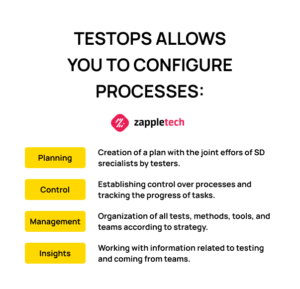
TestOps (QAOps) is considered the next stage in a DevOps culture. To understand the essence of the first term, it is necessary to understand the second. The DevOps approach is centered on the development team. However, everything is not so simple: to simplify and speed up the processes, the development and QA teams must interact with each other. What for?
To achieve the perfect quality of the product! After all, its success in the market depends on it. Ongoing collaboration between teams ensures optimal delivery quality and support for the product when it is already in use by the customer. It is also critical to maintain consistency and continuity of integration (CI) and delivery (CD).
The technique appeared as another step towards optimizing the interaction of specialists in small teams. The main idea is to make developers even stronger using knowledge of managing the product environment. In fact, a DevOps master is someone who is familiar with all the nuances of SDLC, testing tools, security risks as well as pre- and post-release support features.
This approach proved to be simple and reliable, and it became an incentive for new branches such as QAOps. Here QA plays the role of a full-fledged CI/CD participant and is closely related to the development and other operations. QAOps significantly helps in this cooperation: it ensures the stability of the delivery of software solutions, enhances security, and increases speed. In other words, it is responsible for the critical moments of continuous testing (CI, CD) and establishes connections between Dev, Ops, and QA teams.
TestOps allows you to configure processes in the following areas:
- Planning. Selection of priority tasks to be solved, determination of tests and methods, analysis of possible risks. Creation of a plan with the joint efforts of SD specialists by testers, documenting the decisions made.
- Control. Establishing control over processes and tracking the progress of tasks. The goal is to keep monitoring changes and new requirements for the tested project, standardization of essential aspects.
- Management. Organization of all tests, methods, tools, and teams according to an established strategy. Prioritizing tests and interacting with executors, agreeing on naming and labeling.
- Insights. Working with information related to testing and coming from teams to monitor the status of the project and its readiness for release, analysis of the productivity of performers.
So, TestOps allows you to involve several teams in working on a product, improve awareness of methods and DevOps testing tools, establish an exchange of reports and feedback, and ensure transparency of results. As a result, the time spent on completing tasks is reduced, and the project is several steps closer to the launch. Different practices are used to achieve the goal. They depend on which direction TestOps is “shifted”.
Shift-Left and Shift-Right Testing Practices
Speaking of continuous testing, we must mention the shift-left concept. It has been a popular tendency for quite a long time, but recently unexpected trends towards shift-right have arisen. How are the approaches different? It’s simple: the first involves testing the product at the beginning and during the entire SDLC, and the second in the end, i.e., in a production environment. Let’s take a closer look at these TestOps concepts and how they help control software quality.
Shift-left testing emphasizes early and continuous testing throughout the development cycle. By integrating testing activities from the very beginning of the software development lifecycle (SDLC), this approach helps identify and fix defects early, reducing the cost and effort required to resolve issues later. This proactive strategy ensures that potential problems are addressed before they escalate, leading to higher quality software and more efficient development processes.
On the other hand, shift-right testing focuses on testing in a production environment. This approach is particularly useful for validating the software’s behavior under real-world conditions and ensuring that it meets user expectations. By conducting tests after deployment, teams can monitor the software’s performance, reliability, and security in an actual operational setting. This reactive strategy complements the shift-left approach by providing valuable insights into the software’s functionality and user experience.
Incorporating both shift-left and shift-right testing practices within a TestOps framework allows organizations to achieve comprehensive test coverage and maintain high standards of software quality. TestOps integrates these practices with continuous integration and continuous deployment (CI/CD) processes, enhancing communication, control, and distribution of tasks among team members. This holistic approach to testing ensures that every aspect of the software development process is optimized for quality, efficiency, and effectiveness.
By leveraging TestOps, organizations can control software quality more effectively, ensuring that their products meet the highest standards of performance and reliability. This not only improves the end-user experience but also enhances the reputation of the QA team and the organization as a whole.
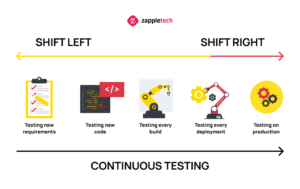
Features of left and right shifts in testing:
1. Shift-left
Key Practices:
- Early Reliability Tests. The performance is checked at the initial stage, considering the expected load. The ability of the architecture to scale is determined, performance is tested, and stability under atypical conditions is studied.
- Configuration control. The IaC environment and the deployment configurations are tested, and a test deployment is performed and rolled back to prevent further errors.
- Monitoring. The state of systems is monitored at the initial stages, and performance is checked in the context of synthetic metrics before moving on to deployment in production environments.
- AIOps. The collection and processing of test results are carried out, the first conclusions are made about the quality of the product, and risks are predicted. It requires advanced AI techniques and tools.
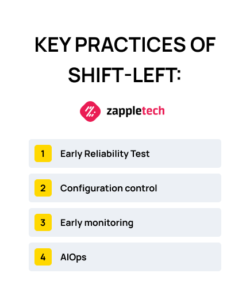
As you can see, this approach allows completing tasks that are usually performed in later stages. It also applies to checking the system’s stability, monitoring, and quality analysis. It prevents small problems from turning into serious ones and slowing down the project’s development.
This concept implies design thinking. It means that specialists focus on the user’s expectations. It makes it easier to find defects in the design and guarantees their timely elimination.
2. Shift-right
The previous approach was focused on meeting quality criteria and business requirements. Everything is different here: shift-right is aimed at improving the performance of the system in real conditions. It implies additional checks before and after the release. By running tests in a production environment, technicians can consider the actual user experience, which is crucial for maintaining and enhancing control software quality.
Shift-right testing allows teams to manage unexpected degradation and crash events and prevent problems. While shift-left is beneficial for agile testing, it opens up fewer opportunities for QA from an end-user point of view. The shift-right practice helps to get feedback from real customers and take steps to improve the reliability and convenience of the system.
In addition, TestOps professionals who follow this practice have the chance to gain full access to the system. What does it mean? Testers can work harder and complete tasks on time, as they are well placed to do so. This comprehensive access allows them to identify and resolve issues that may not be evident in a pre-production environment. Various scenarios are combined with this approach, including those that cannot be implemented in test environments.
By incorporating shift-right practices within a TestOps framework, organizations can achieve a balanced and thorough approach to quality assurance. TestOps integrates both shift-left and shift-right strategies, ensuring continuous improvement and robust control over software quality. This holistic approach leverages the strengths of both testing practices to deliver superior software products.
Shift-right testing also provides valuable insights into how the software performs under actual usage conditions. This real-world feedback is essential for identifying and addressing performance bottlenecks, security vulnerabilities, and usability issues. By responding to real user experiences, teams can make informed decisions that enhance the overall quality and reliability of the software.
Furthermore, the combination of shift-right testing with continuous integration and continuous deployment (CI/CD) practices ensures that any changes or updates to the software are rigorously tested and validated. This synergy enhances the agility and responsiveness of the development process, allowing teams to deliver high-quality software that meets user expectations.
In conclusion, TestOps, with its integration of shift-left and shift-right testing practices, offers a comprehensive approach to controlling software quality. By leveraging both proactive and reactive testing strategies, organizations can ensure that their software products are reliable, performant, and user-friendly. This dual approach not only improves the end-user experience but also strengthens the reputation and effectiveness of the QA team and the organization as a whole.
Key Practices:
- Chaos Engineering. The system is purposely hacked over increased loads to identify weaknesses, risk areas, and probable failures. Based on the results obtained, it is possible to improve the fault tolerance.
- A/B tests. Several versions of the product are studied with the involvement of real users who choose the best option.
- Canary release. The new code is tested in production with the involvement of a small random circle of users. It reduces risks when launching a new version of the product.
- Active monitoring. The path that the user is expected to follow in the program is created and tracked. It gives an insight into all the disruptions that real users might encounter.
- CX tests and analysis. Data related to customer experience (problems of use, requirements for functionality) is collected and analyzed.
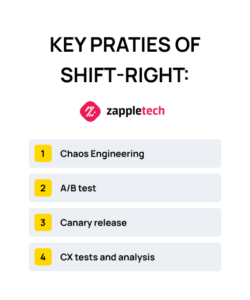
Those who prefer the first concept aim to immediately get the right results to save energy and resources and quickly bring the product to market. In the second case, all possible steps are taken to learn more about customer preferences and implement various scenarios, making the system as convenient as possible in real conditions.
So, TestOps is not only another opportunity to reduce time and money costs. It is a way to expand the creative potential of the team, increase the team spirit, ensure the stable productivity of the performers, and open up new perspectives for the project at any of its stages. A variety of DevOps testing tools, methods, approaches, and practices allows experts to cover different areas of work and behavioral scenarios, predict results, and improve understanding of user experience.
Let’s Summarize
Understanding TestOps best practices is crucial for ensuring the highest quality in software development. By introducing a better way to control software quality through TestOps, you can significantly reduce errors and improve efficiency. Implementing these practices early in the development process ensures a seamless integration of QA, leading to a superior final product.
Embracing TestOps allows your team to identify and address potential issues before they become major problems, thereby saving time and resources. This proactive approach not only enhances the reliability of your software but also accelerates the overall development timeline. Additionally, the continuous feedback loop provided by TestOps fosters a culture of continuous improvement, enabling your team to adapt and optimize processes on the fly.
By integrating TestOps into your workflow, you gain better visibility and control over the entire development lifecycle. This holistic view ensures that all aspects of your software, from functionality to performance, meet the highest standards. Ultimately, adopting TestOps is not just about controlling software quality—it’s about driving innovation and delivering exceptional digital solutions that exceed user expectations.
Using TestOps in the process of working on a digital solution improves the final quality of the IT product thanks to:
continuity of testing;
speed of verification of all software components;
coordinated work of the testing participants;
distribution of tasks between experts;
full control of the testing process and progress;
timely identification of critical errors.
In the end, this positively affects the timing of the digital solution release and its quality.
Implement TestOps to gain a comprehensive view of your project, allowing you to manage and improve every aspect of your software’s performance and functionality.Mikhail BodnarchukCDO, ZappleTech Inc.
Do you want to implement a project of any complexity in time while avoiding errors or costs after software publication? Implement TestOps at the early stages of development and get a top-quality IT solution.
Zapple Tech specializes in QA for projects regardless of their specifics or business direction. We quickly integrate our experts into the team and ensure a fruitful collaboration during development. With our services, you’ll get the best service on the market that will rid your digital product of 99% of possible problems.
Contact our manager for a consultation!
